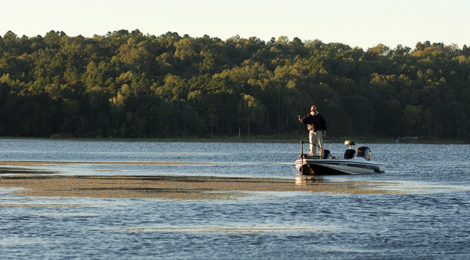
Flipped Out on Punchin’
Top Pro’s Points for gear selection and techniques for flipping or punching.
Story and Photography Matt Williams
It is sometimes hard to find much humor in bass fishing, but I can’t help but crack a grin each time I recall the story behind Tommy Martin’s crushing Bassmaster win on Toledo Bend in November 1981.
The veteran Toledo Bend guide flipped up more than 81 pounds of bass from 30-plus feet of hydrilla to win the three-day event. What’s funny about the deal is the unconventional equipment he relied on to get it done.
“I was using a six-foot, heavy action pistol grip with a 1/2 ounce jig,” recalled Martin, 77. “For years a 1/2-ounce was the heaviest jig you could get, so we pegged a 1/4 ounce slip sinker on top to help get it straight down through the grass on heavy monofilament line. And those pistol grip rods — man, it was something else wrestling a five to six pound bass out of a jungle of deep grass with one of those. We lost a lot of fish. But we did the best we could do with what we had. Things have definitely changed a lot since then as far as the gear we have available. It’s much better.”
While the modern tackle that anglers rely on to snatch bass out of the thick grass is much better suited to task than it was decades ago, one thing that hasn’t changed is the bass’ affinity for playing hide and seek in the heavy stuff.
Martin may have been the first to discover the connection between big bass and matted hydrilla in the early 1970s. That’s when the aquatic plant first showed up in Toledo Bend and Sam Rayburn, both in eastern Texas. Some of the grass was growing in water as deep as 37 feet.
The Nitro pro won numerous tournaments taking a vertical approach around the grass while other bassers chose to skirt the edges or avoided the green stuff altogether.
At one point Martin donned a scuba mask and jumped in the lake so he could get a visual beneath the canopy.








